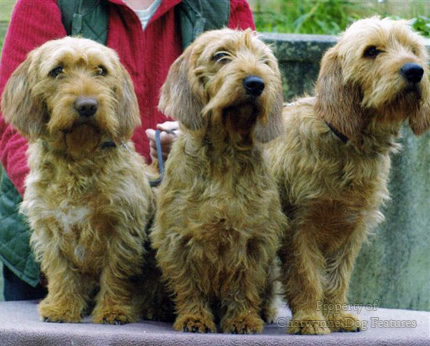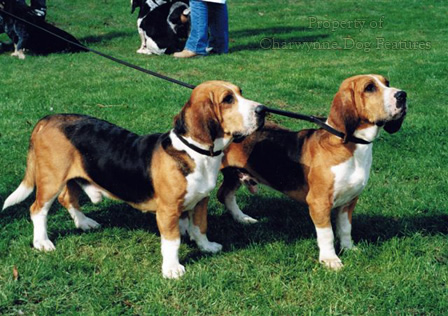403 Hunting Bassets
BASSETS OF ALL SORTS
by David Hancock
"...their heads are hung
With ears that sweep away the morning dew.
Crook-knee'd and dew-lap'd like Thessalian bulls,
Slow in pursuit, but match'd in mouths like bells..."
Those words of Shakespeare's, on hounds, from A Midsummer Night's Dream, make an apt summary of the appearance and performance of Basset-type hounds. The breed we know best in Britain is outnumbered by those of mainland Europe: the Artesian-Normand, the Bleu de Gascogne, the Fauve de Bretagne and the Griffon-Vendeen Petit and Grand. They are still used to hunt hare and rabbit for the gun, excelling in dense cover. But they are also used for flushing game birds, rather like spaniels. I suspect that the type evolved as a 'sport' from the St. Hubert Hound, in its various types, and was then committed to a hunt involving footed rather than mounted hunters.
A writer in the Veterinary Record thirty or so years ago, referred to this type, rather unkindly, as 'achondroplasic dwarfs'. Smythe, in his excellent 'The Conformation of the Dog' (Popular Dogs, 1957), writes: "Some breeds exhibit localized deformities; in the Dachshund and Basset Hound the head and body are normal but the limbs show exaggerated achondroplasia. Legs are short, thick and somewhat crooked. Both the head and the limbs are encased in a skin several sizes too large for the dog, with wrinkled folds. The feet are large." Achondroplasia is a form of dwarfing due to disease affecting the long bones of the limbs before birth; it occurs in cattle and in other breeds of dog. When it is undesired in a breed of dog, the afflicted pups are quickly destroyed.
The inheritance of short legs is complex; Robinson (1989) suggested that shorter legs are dominant over longer legs. He went on to state: "Although polygenic heredity may be assumed for length for most breed differences, this does not mean that major achondroplasic genes do not exist." The worry here for me is that shorter-legged breeds can in time become even shorter and not always for the benefit of the breed. Crooked legs can so easily become painfully crooked legs. It is significant that when the Bassets used for hunting in Britain became too exaggerated, it was the leggier Harrier which provided the best outcross, rather than the Beagle, which was also tried. I believe that Basset Hounds, pure-bred and true to type, in France, Britain and America, have occasionaly produced a large hound pup, with straight proportionately long legs, in an other wise typical Basset litter.
In his most valuable book on hunting, published in the late 16th century, Jacques du Fouilloux makes an early reference to Bassets, describing them as badger dogs. He identified two types: those with a crooked front, which he stated were short-coated and went to ground better, and those with a straight front, which often carried the rough coat and ran game above ground as well as conducting terrier work. Du Fouilloux attributed the first home of these Bassets to the regions of Artois and Flandres. Both these regions have a record over five centuries of producing exceptional hounds.
In his excellent book on the Basset Hound (Popular Dogs, 1968), George Johnston, who knows his hounds, produces a map of north-western Europe showing the distribution of the basset type. This puts the rough-coated variety in north-west France (the Basset Fauve de Bretagne and the Basset Griffon-Vendeen), the smooth-coated variety in the north (the Bassets de Normandie, d'Artois and d'Ardennes) and the south (the Bassets de Saintonge and Bleu de Gascogne), with some smooth-coats on the German-French border in the Vosges and the Black Forest. He also mentions the allied breeds: the Dachshund in Germany, the Niederlaufhund of Switzerland and the Drever of Sweden.
The first French dog show, in Paris in 1863, issued a catalogue which listed Bassets as follows: straight-legged short and long-haired, crooked-legged short and long-haired, Baden Bassets, Burgos, St Domingo, Illyrian and Hungarian Bassets. This shows a Basset diaspora stretching from Brittany to Budapest and from the Black Forest to the Balkans. The Baden Basset would have been the Dachsbracke or badger hound. The Danes had a Dachsbracke too, known there as the Strellufstover, and now embraced by the Drever of northern Scandinavia. These short-legged but usually straight-legged hounds were used to drive game to the waiting guns. It is surprising that, whilst the Swiss have developed several breeds of Niederlaufhunde, the French border areas with Switzerland have none.
The Basset Hound, as a pet or show dog, is now well established in Britain, with over 1000 being registered annually. In America in 1977, nearly 15,000 were registered with the AKC, such was their appeal. Other French Basset breeds are now becoming known here, with the Petit Basset Griffon Vendeen proving the most popular. This is hardly surprising for it is a delightful breed, full of character and charm. A first class book on the breed has recently been published: written by Valerie Link and Linda Skerritt, and published in America by Doral Publishing. Nearly 400 pages long, with a good index, it is a pleasing production in times when so many breed books are disappointingly shallow.
It is ironic that those with show Bassets who criticize the hunting fraternity for their outcross to the Harrier should choose to overlook pioneer breeder Millais's outcrosses to both the Beagle and the Bloodhound. Pure-bred Bassets are still represented in the hunting field by the Albany and the Huckworthy. Ten years ago the West Lodge pack was ¾ Basset, ¼ Harrier but there were also Griffon-Vendeens in the pack. There are several packs of Petit Griffons-Vendeens hunting in Britain. The Ryford Chase has utilised West Country Harrier, Welsh Foxhound and more recently Beagle blood to make the pack less wilful and more biddable.
The Albany was for some time the Basset Hound Club's pack, with some show dogs hunting with them. The American hunting Bassets are often show dogs too. American hunters find two types of Basset Hound: those with high energy, which are lighter in bone, less chunky and longer in leg and the lower energy, more classic hounds which are noticeably more laid-back, in the modern idiom. The former lack the painstaking methodical style of the classic Basset hunt but often 'hunt on' using air scent before picking up ground scent once more. The Americans have trials for hunting in packs and hunting in couples or brace trials. The American Rabbit Hound Association also has a hunt competition for Bassets. In the future we may well have no Bassets hunting.
In 1908 there were nearly forty hunting packs of Bassets in Britain, against just 10 Basset Hounds registered with the Kennel Club in that year. Twelve years ago there were ten packs recognised by The Masters of Basset Hounds Association. Six were straight-legged packs, the others crooked-legged. About half were pure-bred Bassets, the remainder mainly the so-called English Basset, the progeny of the Harrier outcross and more recently Beagle, West Country Harrier and Petit Basset Griffon Vendeen blood too. The first pack made up of English Bassets was the Westerby, whose country lies mainly in Leicestershire, and originally pure-bred Walhampton Bassets. The pure-bred hunting basset lacks much of the excessive wrinkle and exaggerated crooked knee of so many show bench hounds. The Fourshire Bassets of ten years ago were good examples of pure-bred working hounds.
Around 1910, the hunting stock declined appreciably, all too many of the hounds displaying gross exaggeration and even malformation. There were stories of Bassets being carried from the hunting field on stretchers made of sheep hurdles. In 1911 The Masters of Basset Hounds Association was formed and only hounds from recognised packs became eligible for registration. KC-registered hounds were refused entry. The majority of MBHA registrations were Artesian-Normandie in origin. A notable exception was the Sandringham kennel of Basset Griffon-Vendeen owned by Queen Alexandria. But the First World War almost saw the demise of the Basset Hound in England.
Colonel Morrison's work with the Westerby pack from the 1930s saw a steady improvement in fortune. He started with the Basset Artesian-Normandie for its nose and cry, that is its scenting skill and musical baying. He made inspired crosses with the Basset Griffon-Vendeen, the Beagle and the Harrier to enhance drive, stamina and pace. Today's show breeders should note that the improved performance was not vaguely 'expected' from a closed gene pool but pursued by a gifted breeder with an open mind. Millais, the pioneer Basset breeder would have approved.
If you respect and admire functional dogs then it is with sadness that you might view some Bassets on the show bench. There is all too often a poor lay of shoulder, a short upper arm, a looseness of elbow, flat feet or even splay feet and a lack of a ribcage carried well back. Even more apparent are the over-long ears and the over-bent front legs. A cynic might observe that the Basset Hound is a breed much loved by the nation but not so much by some of its breeders. There is a balance to be found in such a breed between breed type and a degree of gross exaggeration which causes discomfort to the dog. Breed lovers should be dog lovers too.